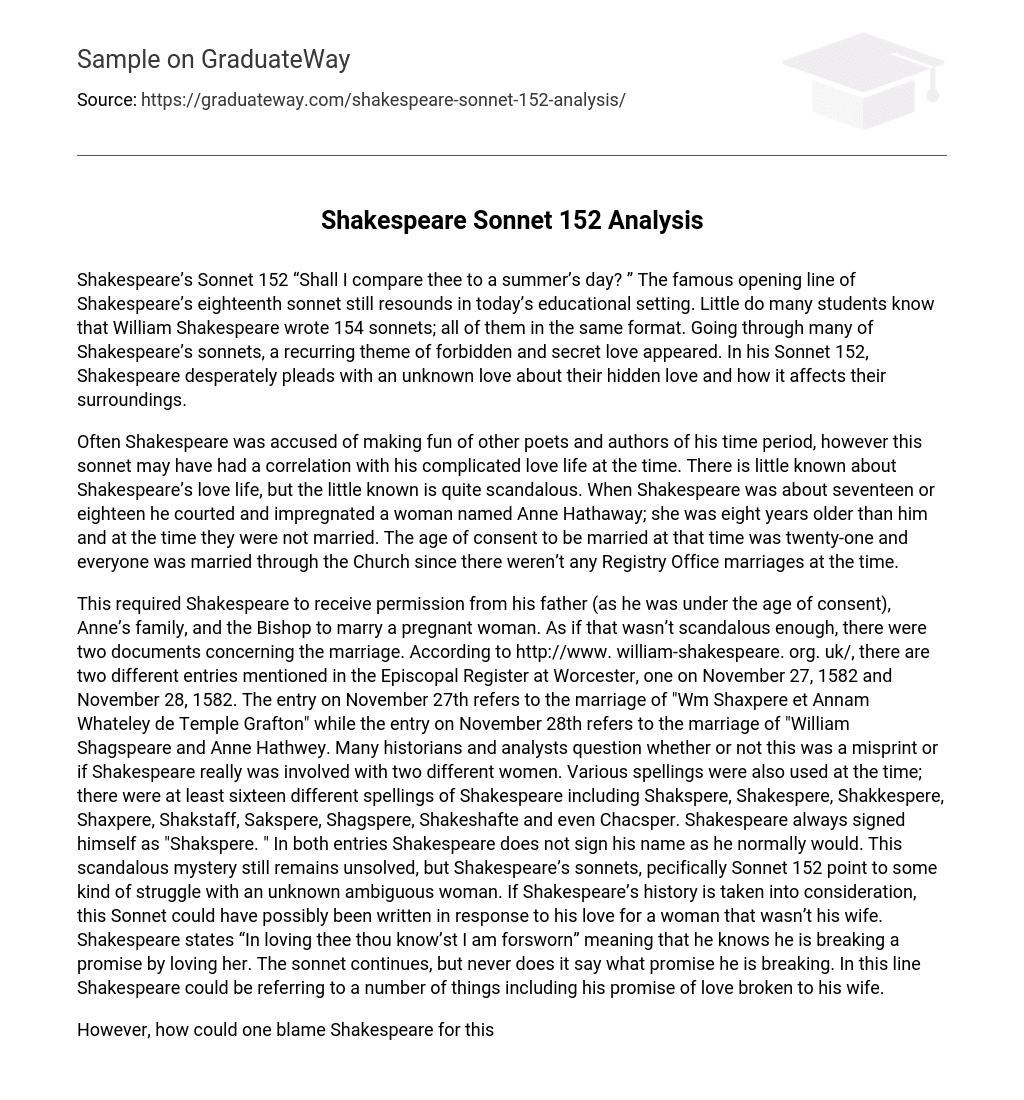Shakespeare’s Sonnet 152, “Shall I compare thee to a summer’s day?”, is widely recognized in modern education. It is worth noting that Shakespeare wrote a total of 154 sonnets, all following the same structure. Upon exploring his sonnets, a recurring theme of forbidden and clandestine love emerged. Sonnet 152 serves as Shakespeare’s impassioned plea to an undisclosed lover regarding their covert love affair and its impact on their surroundings.
Shakespeare is said to have frequently mocked contemporary poets and authors, but this sonnet might actually reveal his chaotic love life at the time. While there is limited information about Shakespeare’s romantic relationships, what little is known is quite scandalous. When Shakespeare was around seventeen or eighteen years old, he pursued Anne Hathaway, a woman eight years older than him. They were not married at the time, which went against the legal age of consent for marriage set at twenty-one. Since Registry Office marriages did not exist during that period, all marriages were conducted through the Church.
Shakespeare needed consent from his father, Anne’s family, and the Bishop to marry Anne, who was pregnant at the time. According to information on http://www.william-shakespeare.org.uk/, there are two records regarding their marriage. The Episcopal Register in Worcester has two separate entries dated November 27, 1582 and November 28, 1582. The entry on November 27 mentions the marriage of “Wm Shaxpere et Annam Whateley de Temple Grafton,” while the entry on November 28 refers to the marriage of “William Shagspeare and Anne Hathwey.” Some historians and analysts raise doubts about whether this could be a misprint or if Shakespeare had involvement with two different women. It is worth noting that during that time, there were various spellings of Shakespeare’s name such as Shakspere, Shakespere, Shakkespere, Shaxpere, Shakstaff, Sakspere, Shagspere, Shakeshafte, and even Chacsper. However, Shakespeare consistently signed himself as “Shakspere.” Notably though in both entries mentioned earlier he did not sign his name as usual. This scandalous mystery remains unsolved; some speculate that Sonnet 152 in Shakespeare’s sonnets might suggest a struggle with an unknown woman. Considering Shakespeare’s personal history suggests that this Sonnet could possibly reflect his love for a woman who was not his wife. In his sonnet he confesses by saying “In loving thee thou know’st I am forsworn,” acknowledging that he knows he is breaking a promise by loving her.While the sonnet continues, it maintains uncertainty about the exact promise he is breaking. This suggests that Shakespeare may be referring to different promises, like his vow of love for his wife.
However, it is difficult to lay blame on Shakespeare for his attraction to another woman. The only thing that held his marriage together was a moment of youthful desire. This sonnet raises queries about Shakespeare’s romantic life and the intended recipient of the sonnet. Sonnet 152 goes on to highlight the specific promises that the lover has broken: “In act thy bed-vow broke…In vowing new hate after new love bearing.” This implies that Shakespeare’s lover has been unfaithful to her husband by engaging in sexual relations with another man, likely Shakespeare himself, but has vowed to despise her new lover.
Why? The woman appears to be burdened with guilt for betraying her husband and has made efforts to distance herself from her new lover, Shakespeare. Shakespeare questions her, saying, “Why…do I accuse thee, when I break twenty (vows)?” He acknowledges that he has no right to condemn her actions since he himself is guilty of wrongdoing by engaging in an affair with a married woman and possibly being unfaithful to his own wife. This sonnet could possibly serve as a goodbye to their clandestine relationship.
Shakespeare’s previous sonnets revolve around his inner turmoil of loving an unknown woman. However, in the two subsequent sonnets, he expresses his renewed affection for his mistress. In this particular sonnet, Shakespeare conveys to the woman that he has lost his genuine faith in her. He proceeds to recount the extent of his praises and vows to her, acknowledging that he had always been aware of her lack of kindness, love, truth, and constancy as he later admits within the sonnet.
Shakespeare acknowledges that he blinded himself by idolizing this woman as flawlessly perfect. Such emotions are widespread in present-day society. This sonnet illustrates the typical sentiments experienced by a man or woman who has betrayed a promise of marriage or love to another. Shakespeare’s guilt aligns with his personal sadness upon realizing that this woman is not flawless; he had merely constructed her perfection in his imagination. However, isn’t this often the scenario for most adulterers?
The primary reason for cheating on a spouse is the overwhelming power of lust and the disregard for moral reasoning. In such situations, the adulterer tries to justify their actions by claiming that their spouse cannot provide happiness, while the new lover offers a perfect and fabricated sense of fulfillment. In Sonnet 152 by Shakespeare, the initial impression is that of a miserable man submerged in his sorrows caused by infidelity. Yet, upon closer examination, the themes of judgment and widespread adultery can be related to present-day society.





